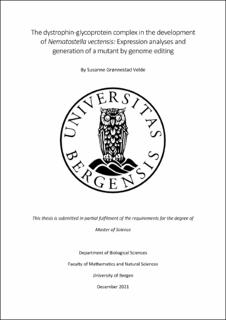The dystrophin-glycoprotein complex in the development of Nematostella vectensis: Expression analyses and generation of a mutant by genome editing
Master thesis
Permanent lenke
https://hdl.handle.net/11250/2834599Utgivelsesdato
2021-12-03Metadata
Vis full innførselSamlinger
Sammendrag
The development and function of cells in the nervous system and the musculature require regulated interactions with the extracellular matrix. The dystrophin-glycoprotein complex is an important regulator of these interactions. A central component of this complex is dystroglycan, a membrane protein that is heavily glycosylated on its extracellular part. This glycosylation is initiated by O-mannosyltransferases and is then expanded by a series of additional glycosyltransferases. The sea anemone Nematostella vectensis represents an evolutionary ancient group of animals and has emerged as a powerful tool to study neurogenesis and development in an evolutionary context. The genome of Nematostella encodes all members of the dystrophin-glycoprotein complex, introducing the question of their role in this animal. In this study, we show that the expression pattern of dystroglycan and five glycosyltransferases are compatible with different roles of dystroglycan O- mannosylation. By in-situ hybridization, we identified POMGNT1, POMT1 and POMT2 to display a similar expression pattern throughout early development. Double fluorescence in- situ hybridization shows the enzymes to be co-expressed with each other, suggesting a shared function. Difference in early expression between the glycosyltransferases and dystroglycan might indicate a dystroglycan-independent function of O-mannosylation, whereas the similar expression in later stages indicate a potential role for dystroglycan-dependent O-mannosylation during Nematostella development. Furthermore, double fluorescence in-situ hybridization found POMGNT1 to be expressed in FoxQ2d-expressing sensory cells, suggesting the enzyme to have a role in sensory cells. Finally, CRISPR/Cas9 was successfully used to introduce a mutation in the gene of POMGNT1, to further study the function of this glycosyltransferase and its substrate in Nematostella development. We anticipate this study to be a starting point for future studies to provide insight on the role of the dystrophin- glycoprotein complex and the necessity of alpha-dystroglycan O-mannosylation on the nervous and muscular systems of Nematostella vectensis.
